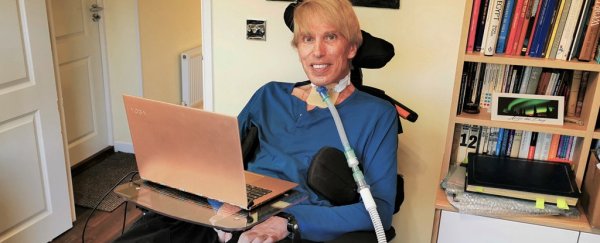British roboticist Peter Scott-Morgan doesn't want you to see him as a man who died from a neurodegenerative disease. He wants to become Peter 2.0 – the most advanced cyborg ever.
There's an extensive list of medical devices already helping him breathe, feed, and communicate; those technologies are set to grow in the near future. But, according to Scott-Morgan, this isn't about staving off death; it's about evolving.
"Yes, I know, this all sounds like science fiction," he admits on his blog.
"But some of the top brains in the world, in an alliance of some of the most powerful hi-tech megacorporations, are set to make it happen – by the end of this year."
The timeline more or less coincides with the amount of time Scott-Morgan has left. Statistically speaking, at least. But he has every intention of seeing what 2020 has in store, and more.
His biological body is declining from a terminal condition that slowly destroys the nerves, called motor neurone disease. It's the same neurodegenerative disorder the physicist Stephen Hawking was diagnosed with in 1963, leaving him relying on technology for mobility and speech.
Like Hawking's, Scott-Morgan's nervous system is slowly losing its ability to govern key functions and voluntary movements, leaving him in a state of all-but-complete paralysis.
Earlier this week, the 61-year-old man returned home after nearly a month in intensive care recovering from a number of life-saving – or, as he sees it, enhancing – procedures.
Those include a mini-ventilator (quieter than Darth Vader's, he boasts cheerfully), as well as a feeding tube into his stomach and a colostomy bag. Scott-Morgan has also had his voice box removed to reduce the risk of aspirating his saliva, and communicates with synthetic speech.
Every new piece of engineering is being viewed "an upgrade" rather than a substitute. But the best is apparently yet to come.
"We are now only a year or two away from being able to pull off something revolutionary. All the technology pretty well already exists in isolation," he says.
This includes tech innovations such as brain-computer interfaces and eye tracking that are still on the horizon. But Scott-Morgan envisions more than that – he sees a future where Peter 2.0 isn't so much a body in physical space, but a mind in a digital landscape.
"Peter 2.0 can only do it because he's a lot more than just a biological body remotely controlling two doppelgangers," he explains.
Together with his husband Francis, Scott-Morgan has set up a foundation that aims to research ethical use of AI and robotics to augment anybody who feels restricted by illness, age, or disability.
The future is already here, in many ways. But to quote the science fiction writer William Gibson, "it's just not very evenly distributed".
To widen access to life-saving treatments and technologies for people with motor neurone disease, their 'Right to Thrive' campaign has been calling on members of parliament for support.
Fundamentally, the campaign's message is less about building futuristic cyborgs or living in a digital utopia. Those images might grab our attention, but it's a depressing reality that we need to appeal to the imagination at all.
Because Peter 2.0 is really about something more.
"At its core, the RIGHT TO THRIVE is about fair access, genuine choice, and healthcare equality," he writes.
Maybe we'll be hearing from Peter 2.0 for some time yet. We hope so.
But even if critical technology doesn't arrive in time for Scott-Morgan, the roboticist's message of transformation is still an important one. It's just the rest of society that could do with a little evolving when it comes to chronic illness and disability.
